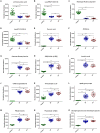Serum metabolomics analysis of deficiency pattern and excess pattern in patients with rheumatoid arthritis
- PMID: 35706052
- PMCID: PMC9199155
- DOI: 10.1186/s13020-022-00632-5
Serum metabolomics analysis of deficiency pattern and excess pattern in patients with rheumatoid arthritis
Abstract
Background: Rheumatoid arthritis (RA) is a chronic and refractory autoimmune disease. Deficiency pattern (DP) and excess pattern (EP), as crucial types of Chinese medicine pattern diagnoses published by International Classification of Diseases 11th Revision (ICD-11), could provide new strategies for RA diagnosis. However, the biological basis of DP and EP of RA is not explicit.
Methods: 19 female RA DP patients, 41 female RA EP patients and 30 female healthy participants were included in the study. The serums of participants were collected and analyzed by metabolomics based on ultra-performance liquid chromatography coupled with quadrupole time-of-flight mass spectrometry to profile metabolic characteristics of RA DP and EP. Furthermore, bioinformatics analysis results were obtained by using Ingenuity Pathway Analysis (IPA) and statistical analysis was performed by SAS version 9.4 for further identification of potential biomarkers.
Results: Serum metabolic profiling revealed 25 and 24 differential metabolites in RA DP and EP respectively, and 19 metabolites were common to RA DP and EP. Compared with DP group, L-Homocysteic acid, LysoPE(P-16:0/0:0), N(omega)-Hydroxyarginine and LysoPC(16:0/0:0) decreased (P < 0.05), and Pyruvic acid, D-Ribose, Gamma-Glutamylserine, PE(22:0/24:1(15Z)), Inosinic acid increased (P < 0.05) in EP group. Menawhile, S-Nitrosoglutathione, 5-Thymidylic acid, SN38 glucuronide, PE(22:0/24:0), PC(24:0/24:1(15Z)) and Bisdiphosphoinositol tetrakisphosphate increased significantly in DP group compared to EP group (P < 0.05). For the unique metabolites, bioinformatics analysis results showed that 5-Methoxytryptamine involved in Melatonin Degradation II and Superpathway of Melatonin Degradation is the key metabolite to RA DP. Meanwhile, GABA is the key metabolite in EP group, which involved in Glutamate Dependent Acid Resistance, GABA Receptor Signaling, Glutamate Degradation III (via 4-aminobutyrate) and 4-aminobutyrate Degradation I. Bioinformatics analysis between unique metabolites of RA DP and EP groups with human target genes for RA showed that 5-methoxytryptamine and LysoPC(18:1(9Z)/0:0), the unique metabolites of RA DP, might participate in colorectal cancer metastasis signaling, tumor microenvironment pathway, apoptosis signaling, MYC mediated apoptosis signaling, erythropoietin signaling pathway and LXR/RXR activation. Simultaneously, GABA, LysoPA(18:1(9Z)/0:0) and L-Targinine, the unique metabolites of RA EP, might participate in neuroinflammation signaling pathway, osteoarthritis pathway, glucocorticoid receptor signaling, ILK signaling, IL-17 signaling and HIF1α signaling.
Conclusions: The study indicates that serum metabolomics preliminarily revealed the biological basis of RA DP and EP. 5-methoxytryptamine, LysoPC(18:1(9Z)/0:0) and GABA, LysoPA(18:1(9Z)/0:0), L-Targinine might be the predictors to distinguish the DP and EP of RA respectively. These interesting results provide thoughts for further study of traditional medicine patterns of ICD-11. It also contributes to provide strategy for personalized precision treatment of RA and further validation is needed.
Keywords: Deficiency pattern; Excess pattern; Rheumatoid arthritis; Serum metabolomics.
© 2022. The Author(s).
Conflict of interest statement
These authors declare that there are no conflicts of interest regarding this work.
Figures









Similar articles
-
The Gut Microbiome and Metabolites Are Altered and Interrelated in Patients With Rheumatoid Arthritis.Front Cell Infect Microbiol. 2022 Jan 25;11:763507. doi: 10.3389/fcimb.2021.763507. eCollection 2021. Front Cell Infect Microbiol. 2022. PMID: 35145919 Free PMC article.
-
The change of plasma metabolic profile and gut microbiome dysbiosis in patients with rheumatoid arthritis.Front Microbiol. 2022 Oct 18;13:931431. doi: 10.3389/fmicb.2022.931431. eCollection 2022. Front Microbiol. 2022. PMID: 36329847 Free PMC article.
-
[Mechanism of Gardeniae Fructus in ameliorating rheumatoid arthritis based on metabolomics and intestinal microbiota].Zhongguo Zhong Yao Za Zhi. 2023 Jul;48(13):3602-3611. doi: 10.19540/j.cnki.cjcmm.20230411.401. Zhongguo Zhong Yao Za Zhi. 2023. PMID: 37474993 Chinese.
-
Metabolomics in rheumatoid arthritis: Advances and review.Front Immunol. 2022 Aug 11;13:961708. doi: 10.3389/fimmu.2022.961708. eCollection 2022. Front Immunol. 2022. PMID: 36032122 Free PMC article. Review.
-
Differential Metabolome in Rheumatoid Arthritis: a Brief Perspective.Curr Rheumatol Rep. 2021 Apr 28;23(6):42. doi: 10.1007/s11926-021-00989-w. Curr Rheumatol Rep. 2021. PMID: 33913028 Review.
Cited by
-
Application of metabolomics in the classification of traditional Chinese medicine syndromes in rheumatoid arthritis.Clin Rheumatol. 2025 Apr;44(4):1493-1504. doi: 10.1007/s10067-025-07373-4. Epub 2025 Feb 26. Clin Rheumatol. 2025. PMID: 40011356
-
Temporal, spatial and demographic distributions characteristics of COVID-19 symptom clusters from chinese medicine perspective: a systematic cross-sectional study in China from 2019 to 2023.Chin Med. 2024 Dec 18;19(1):171. doi: 10.1186/s13020-024-01043-4. Chin Med. 2024. PMID: 39695848 Free PMC article.
-
Integrating network pharmacology, IPA, and molecular docking to reveal the anti-osteoporosis effects of EA and EB via the FAK pathway.Front Pharmacol. 2025 Jul 2;16:1532665. doi: 10.3389/fphar.2025.1532665. eCollection 2025. Front Pharmacol. 2025. PMID: 40672377 Free PMC article.
-
Comprehensive biomarker analysis of metabolomics in different syndromes in traditional Chinese medical for prediabetes mellitus.Chin Med. 2024 Aug 25;19(1):114. doi: 10.1186/s13020-024-00983-1. Chin Med. 2024. PMID: 39183283 Free PMC article.
-
Integrated metabolomics and network analysis reveal changes in lipid metabolisms of tripterygium glycosides tablets in rats with collagen-induced arthritis.Comput Struct Biotechnol J. 2023 Feb 28;21:1828-1842. doi: 10.1016/j.csbj.2023.02.050. eCollection 2023. Comput Struct Biotechnol J. 2023. PMID: 36923473 Free PMC article.
References
-
- Fan D, Xia Y, Lu C, Ye Q, Xi X, Wang Q, Wang Z, Wang C, Xiao C. Regulatory role of the RNA N6-methyladenosine modification in immunoregulatory cells and immune-related bone homeostasis associated with rheumatoid arthritis. Front cell Dev Biol. 2020;8:627893. doi: 10.3389/fcell.2020.627893. - DOI - PMC - PubMed
-
- Maeda-Minami A, Yoshino T, Katayama K, Horiba Y, Hikiami H, Shimada Y, Namiki T, Tahara E, Minamizawa K, Muramatsu S, Yamaguchi R, Imoto S, Miyano S, Mima H, Mimura M, Nakamura T, Watanabe K. Discrimination of prediction models between cold-heat and deficiency-excess patterns. Complement Ther Med. 2020;49:102353. doi: 10.1016/j.ctim.2020.102353. - DOI - PubMed
Grants and funding
LinkOut - more resources
Full Text Sources

